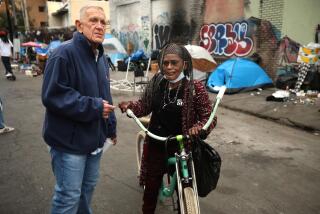Lesson of the King Case: The Risk of Shuttle Justice : Law: Moving urban blacks and Latinos to white suburban enclaves for trial undercuts the perceived fairness of the ensuing trial and verdict.
- Share via
In the week before the verdicts in the Rodney G. King civil-rights trial, the condition of Los Angeles’ collective psyche was that of the Dustin Hoffman character in the movie “Marathon Man”: a bewildered and fearful city strapped to a chair with The Media the crazed Nazi dentist screaming incessantly, “Is it safe, yet? Is it safe, yet?”
Whether it is safe depends on how much, if anything, we have learned from the two trials growing out of the videotaped King beating.
The riot sparked by the first trial was, in part, a reaction both to its not-guilty verdicts and the process by which they were obtained. The venue change to Simi Valley displayed a clear insensitivity to valid minority concerns about the jury’s composition and whether the jury pool from which the jurors were drawn reflected a cross-section of the community.
The lesson should have been simple: Moving urban blacks and Latinos to suburban white enclaves for trial is civically unacceptable, because, as the riot partly revealed, the community questions the fundamental fairness of the ensuing trial and verdict.
The Los Angeles Superior Court continues to move minority defendants from one courthouse to another, largely based upon where a courtroom might be open. It is a race-neutral, mechanical policy of matching cases to courtrooms. Nevertheless, many of the transferred defendants are central-city blacks or Latinos who find themselves tried in Pomona or Van Nuys courthouses, far from the scenes of their alleged crimes, by juries drawn from largely white suburbs. Meanwhile, the county jury commissioner reports that nearly 70% of the jurors in Compton (90% nonwhite) and downtown Los Angeles (80% nonwhite) are Anglos.
On at least four occasions in the last two years, the U.S. Supreme Court has reversed cases in which members of minority groups were removed from juries by lawyers using race-based selection methods. The court has ruled that these methods deny a defendant his or her 6th Amendment right to “an impartial jury of the state and district wherein the crime shall have been committed.”
Unfortunately, the Founding Fathers could not have imagined the megalopolis of Los Angeles in 1789. Two hundred years later, the California Supreme Court, in two cases, appeared to interpret the 6th Amendment to mean that a criminal trial could be transferred to any court in Los Angeles County, no matter where the offense was committed. Thus, it would be constitutionally permissible for a crime allegedly committed in the port district of San Pedro to be tried in the Mojave Desert community of Lancaster.
In both state Supreme Court cases, the court’s sole African-American, Justice Allen E. Broussard, dissented, essentially arguing that Lancaster and Compton had nothing in common, except for the geopolitical happenstance that they were in the same county. Broussard’s view, unfortunately, was lost on the majority, who, based on the holdings, apparently would allow a barrio case to be transferred to Munich if the Bavarian city happened to be inside the county borders.
Moving defendants from one area to another has enormous effects on the racial and ethnic composition of the jury pool. Even if the policy is constitutional, which is not an entirely settled question, it is terribly unwise.
Just 30 years ago, a dozen states had laws forbidding blacks from sitting on juries. Still more states used other devious means to keep them off. So it is understandable that the African-American community eyes jury selection with an interest borne of historical exclusion.
There is also reality. Virtually all defense attorneys believe, supported by ample evidence, that white juries are far more prone to convict a black or Latino than an integrated jury. Since transferring cases to outlying courts invariably decreases the number of available minority jurors, it alters who will sit on the jury, which, in turn, may alter the outcome.
This is the lesson of the second King-beating trial, whose jury included two African-Americans and a Latino. Lawyers and judges know from experience that potential jurors often are prejudiced, whether consciously or unconsciously. An integrated jury pool is necessary, not because it will be unprejudiced (although that is what the judge will tell them), but because putting minority group members in the jury room hopefully offsets prejudice by suppressing its expression.
Certain odious lines of debate remain unmentioned when members of the defendant’s minority group are on the jury. It was the principal reason why Judge John G. Davies refused to allow the lawyers for the four police officers in the King civil-rights trial to peremptorily challenge an African-American based on “his neighborhood.” Defense counsel were hard put to distinguish how “neighborhood” differed from “race.” The juror stayed. The outcome changed.
Some Simi Valley jurors have been quoted as saying that King “asked for it” or King “shouldn’t have been out there.” It would be hard to believe that this line could be pursued on the second King jury. Presumably, the black jurors would have become enraged at the thought of King “asking for” 50-odd baton blows.
Superior Court Presiding Judge Robert Mallano has publicly urged that more African-American judges be appointed, stating that: “Justice must not only be fair, it must also appear to be fair.” The same is true of the criminal-case transfer policy. New York City does not send its minority cases out to Long Island; Chicago doesn’t try its felony cases in Cicero.
So the answer to the question “Is it safe, yet?” depends on first answering another question: “Is it fair, yet?” When that answer is “yes,” we will not even have to ask the other question.
More to Read
Sign up for Essential California
The most important California stories and recommendations in your inbox every morning.
You may occasionally receive promotional content from the Los Angeles Times.













